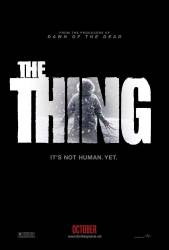Factual error: Winter in Antarctica would not have a night and day as portrayed, with the amount of light changing so much during the course of 24 hours.
Factual error: The very first time we see Kate, when she is examining the extracted specimen, she is listening to music on molded plastic headphones that were not available in 1982. Smaller headphones such as these, designed at the time for listening to Walkman-like portable equipment would have had a metal band going over the head, holding the earpieces in place.
Factual error: When they decide to disable the snow vehicles in order to keep anybody from leaving the base, they decide to disable the engines by cutting the spark plug wires with mechanics sheers. The only problem is that the engines in the snow vehicles (you can hear this to be true) are diesel engines - and diesel engines do not have spark plugs at all. The plugs in the movie were for gasoline engines.






Suggested correction: It is also established in this film that the creature cannot perfectly imitate inorganic materials; the tooth fillings, metal plate, etc. Kate knows that Carter is The Thing and asks him a trick question about his earring to confirm it. The fact that The Thing reaches for the wrong ear means that it didn't know where the earring really was because it cannot perfectly imitate inorganic materials. There is no mistake here.
THGhost
The mistake has nothing to do with The Thing not being able to imitate inorganic material. The mistake is The Thing has all the memories and thus should know which ear was pierced based on these memories.
Bishop73
This goes with my theory that he was actually human because he didn't try to assimilate her when they we're alone and far away from people, and he didn't change when he was threatened and accused which was backed by (potentially false if the theory is correct) evidence which would make it defend itself.
You're obviously wrong here. The Thing imitates the human perfectly including the memory and I'm pretty sure that if you only have one ear pierced you'd know which one is it, therefore the imitation would know.